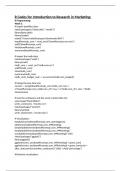Samenvatting
Summary Intro. To Research in Marketing Spring R Codes Assignments
This document includes all the necessary codes to pass the assignments for R for the course Introduction to Research in Marketing. Each week the assignments differ in different versions, however only small indicated changes need to be made in the coding in the first few steps to cover the different...
[Meer zien]




